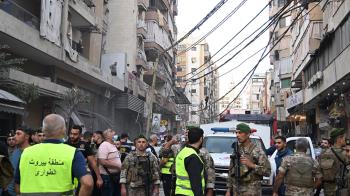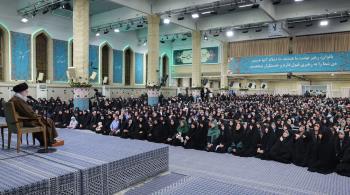Alwaght- Not long after liberating the Eastern Ghouta from the terrorists, the Syrian army on May 21 reclaimed the militant-held Al-Hajar al-Aswad and Yarmouk Camp in the capital’s suburbs, taking what many analysts believe to be the final step to secure a full victory over the foreign-backed terrorists. After the Syrian has managed to cleanse the capital Damascus and its outskirts from the terrorist groups, reports emerged that government forces will continue its cleansing campaign in the south of the country, setting Daraa province as the next target.
After the recent statement on the next push, the field reports suggest that the Syrian army is amassing its forces to assault the terrorists in Daraa, located on the southern borders of Jordan and north of the Quneitra province on the borders of the occupied Golan Heights. On May 26, Syrian helicopters dropped hundreds of leaflets on Ankhal, a town in the northern outskirts of Daraa calling on terrorists to lay down their arms to help save their lives, settle the crisis, and prevent a severe battle.
All these developments bear the idea that the central government in Syria has made its mind to return its governance across the country. But in the meantime, the US is responding negatively to the government’s decision to take back Daraa.
Shortly after the Syrian announcement, the US Department of State issued a statement asking Russia, a backer to the upcoming operation, to dissuade the government from pressing ahead with Daraa assault plan. The US warned that Syria should not launch its anticipated operation in the “de-escalation zones”, which were agreed upon last year with Russia and Jordan and included much of southern Syria, and specifically Daraa. Washington threatened it will take "firm and appropriate measures” in response.
The State Department Spokeswoman Heather Nauert said that the US is concerned to see the Syrian forces are scheduled to launch a recapture campaign in an area included in last year’s ceasefire pact.
"As a guarantor of this de-escalation area with Russia and Jordan, the United States will take firm and appropriate measures in response to Assad regime violations,” she said in the statement.
This American statement exposes the fact that since the beginning of the Syrian crisis in March 2011, Washington has never cared about the human rights and the Syrians and its recent reaction is no exception. It opposes a campaign which is aimed at freeing the Syrian civilians from terrorists. But what do the Americans seek behind their statement?
Daraa geopolitically significance for Israel protection
The most important factor driving the US efforts to set up roadblocks in front of the Syrian army’s liberation of Daraa is the province’s significance for the Israeli regime’s security. In the past years, the terrorists’ capture of Daraa and Quneitra made a secure buffer zone to the Israelis. Tel Aviv intensively supported the anti-Damascus terrorists near the Jordan borders and also Golan Heights in a bid to reduce security risks. The Israeli leaders are well aware that the central government’s reclaiming of the southwestern regions will broaden Damascus’s strategic depth. And so, the strategic areas occupied by Israeli regime, particularly in the north, will be easy targets to potential Syrian rocket and mortar attacks in case of a provocation by the Israeli military.
With 367,000 square kilometers of size and 1.270 million of the population, Daraa borders Damascus from the north, Jordan from the south, Quneitra from the west, and As-Suwayda from the east. In the past, the city served as an important ground route for the Syrian and Jordanian travelers made their trips visa-free. The province also served as a significant trade point between the two neighbors. But as the multi-fronted conflict burgeoned across the Arab country, the foreign-sponsored militants seized a string of Daraa suburban towns such as including Dael, Abta’a, Mahja, as well as Tringa, Jabat Al-Khashab, Ovania, and Al-Makaser towns in Quneitra.
Now the Americans hold the idea that if these towns in the two provinces are recaptured from the terrorists, the Israeli regime should expect a surge in the security threats. So, the protecting Israeli regime is the central theme of Washington’s stark contrast to the return of the control of Daraa to the government.
Need for enduring crisis for continued military intervention
The US has always sought to fuel crisis in Syria and even in West Asia region to maintain its military presence. Therefore, the US measures to prevent Damascus from regaining control over Daraa, which has been in terrorists’ hands for over five years could be justified in this terms. Without any doubt, Americans know that according to international laws, the government, led by President Bashar al-Assad, as the only legitimate ruling body in Syria has every right to take back what remains of the terrorist-held regions. This legal right strips the US of any justification or excuse under any conditions to stop the Syrian army from spreading the rule of government within its territorial sovereignty borders.
Despite these legal obstacles to their meddling in Syrian operations, the Americans still seek to keep the fire of 8-year-old crisis burning at any price to serve their Damascus government impairment agenda on the one hand and build ground for their uninvited forces to remain stationed on the Syrian soil on the other hand.
Additionally, the US wants the devastating conflict to endure in south and west of Syria so that the government is distracted from the northern and northeastern fronts which are the centers of the American forces’ deployment in the war-ravaged country. Washington is highly worried that renewed clashes can result in losing rich oilfields in Deir ez-Zor and Hasaka, currently held by its militant allies the Syrian Democratic Forces.



























